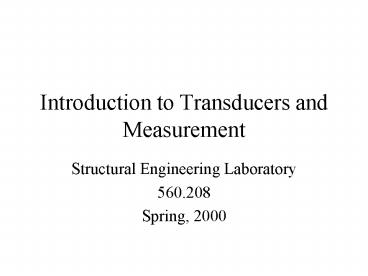Introduction to Transducers and Measurement - PowerPoint PPT Presentation
1 / 12
Title:
Introduction to Transducers and Measurement
Description:
Exposure to theory of operation of several transducers ... Handles and - displacements through winding direction of secondary coils ... – PowerPoint PPT presentation
Number of Views:1044
Avg rating:3.0/5.0
Title: Introduction to Transducers and Measurement
1
Introduction to Transducers and Measurement
- Structural Engineering Laboratory
- 560.208
- Spring, 2000
2
Goals
- Introduction to basic measurement equipment
- Exposure to theory of operation of several
transducers - Become comfortable with transducers to be used
later in the semester - Acquire basic strain-gauging skills
3
Transducer
- A device that converts a physical measurement
into an electrical signal. - Types
- passive (need external power supply)
- active (no power required)
- Calibration required
- Reliability, non-interference, etc..
4
Quantities of Interest
- Force/load
- Stress (normal, shear)
- Displacement
- Strain (normal, shear)
- Acceleration/velocity
- Pressure
5
Measuring Strain
- Two major approaches
- electrical resistance gauges
- optical methods
- Required characteristics
- high spatial resolution
- temperature insensitivity
- high frequency response for dynamic measurements
6
Measuring Strain, ctd.
- Resistance gauges
- resistance of a conductor changes with change in
length (linearly) - incorporate in a Wheatstone bridge circuit
- supply stable power
- measure resistance change
- calibrate to strain
- one or two active arms
7
Measuring Displacement
- Mechanical
- Surveying e.g., laser
- Dial Gauge
- Electrical/electronic
- Linear variable differential transformer (LVDT)
- Indirect measurement
- Calibrate induced strain in a strain link
8
The LVDT
- Principle of operation
- AC output voltage proportional to displacement of
(magnetic) core element - Primary coil provides excitation
- Secondary coils excited proportional to number of
coils exposed. - Small displacements (can have big LVDTs)
- Handles and - displacements through winding
direction of secondary coils
9
Measuring Force and Pressure
- Basic principle
- Deformable element (very stiff)
- Apply load (pressure)
- Induce strains in element
- Calibrate strains with load (pressure)
- Stress?
10
Measuring Motion
- Displacement
- Use e.g., LVDT
- Velocity
- Moving magnet in a coil induces voltage
- Acceleration
- Two components
- Inertial mass
- Mass position measured via displacement (e.g.,
optical, LVDT) or piezoelectric means.
11
Laboratory Exercise
- Apply strain gauge to test element of known
dimensions - Load test specimens incrementally
- Record load, measure strain
- Calculate stress at different load levels
- Plot stress-strain curve for material
- Estimate Youngs modulus
12
Summary Report Requirements
- Schematic of test setup
- Record details of gauges used and equipment
(available on web site) - Record dimensions of specimen
- Table of load/strain/stress calculations
- Stress-strain curve
- Youngs modulus estimate
- Make sure all group members names are indicated
and signed off.

